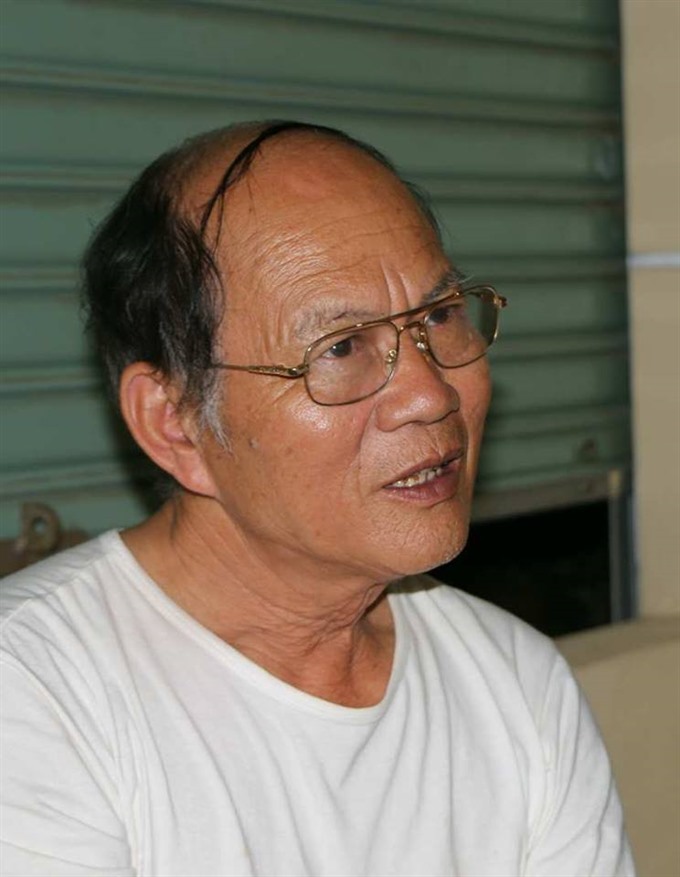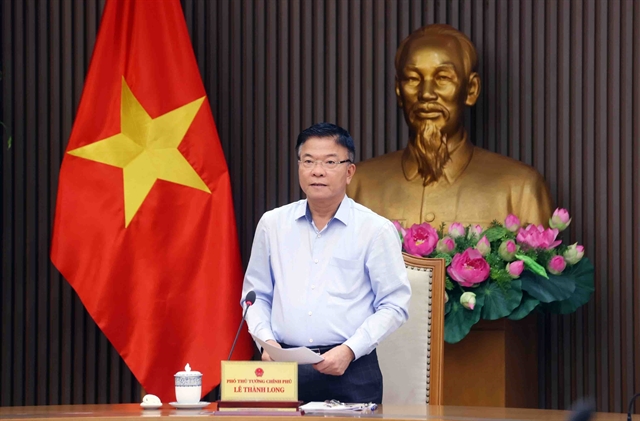 Features
Features

The nation remembers with undying gratitude the martyrs of Quảng Trị 72, the fiercest battle of the prolonged American War. But the fight is far from over, writes Phạm Hoàng Anh
| Requiem: Paper lanterns are released into the Thạch Hãn River from a boat. Thousands of soldiers crossed the river to join the historic battle for control of the Quảng Trị Citadel in 1972. — VNS Photo Đoàn Tùng |
And in a prolonged war, some battles are fiercer and more brutal.
One of the fiercest battles of the anti-American War was fought in the central province of Quảng Trị 45 years ago. In fact, the battle has gone down as one of the bloodiest in Việt Nam’s long history of independence struggles against foreign invaders, including colonialists and imperialists.
The nation revisits this battle every year in the month of July, remembering the heroic spirit that the nation’s soldiers displayed through out 81 long days.
The province has been site of strategic importance for a long time, and the Quảng Trị Citadel, built during the reign of King Gia Long and finished in 1837 by his son King Minh Mạng, has often been an area of conquest by warring sides.
The citadel was a major military and administrative centre of the region during the feudal days and during the French colonial period.
The latest fight for the Old Citadel commenced on June 28, 1972 and lasted until September 26. The 81-day battle, commonly referred to by Vietnamese veterans as Quảng Trị 72, is also called the Stalingrad of the anti-American War in Việt Nam.
War accounts estimate that the combined firepower of American “flying fortress” B-52s, the 7th Fleet and numerous artillery units dropped some 328,000 tonnes of bombs and shells, seven times that of the atomic bomb dropped on Hiroshima during the Second World War, in the fight for the citadel, which has a diameter of a bit over 2,000m.
| Missing a loved one: Nguyễn Văn Huân, 62, a Quảng Trị 72 veteran from Thái Bình Province, sits by the grave of his older brother, who served and died. Huấn had found his brother’s grave for the first time. — VNS Photo Hồng Vân |
The tonnage means each Vietnamese liberation fighter in the battle was the target of more than a 100 bombs and 200 artillery shells. By the end of the battle the small but beautiful town of more than 10,000 houses was almost wiped out from the map.
Against all odds, the fighters held on. When one fell, another rose up to take his place. “It was an honour to fight for the land of our forefathers,” said Nguyễn Thanh Bình, a Quảng Trị native and recon officer of the 8th Regiment, one of the Vietnamese army’s major forces in the historic battle.
| Tribute: Nguyễn Văn Huấn (First left) and his comrades pray at the grave of his brother. — VNS Photo Hồng Vân |
Bình’s unit was among the first to enter the Old Citadel after it was taken by the Viet Nam People’s Army. His unit was assigned the task of guarding the Long Hưng Junction, a crucial outpost of the liberation force south of the citadel.
“We fought wave after wave of the enemy’s attacks. On some days, they staged 7-8 attacks to overrun our position,” Bình recalled.
“The fighting was fierce. We lost far too many men and had to request reinforcements almost everyday.”
As a recon officer, it was his task to guide the reinforcements, who gathered on the banks of the Thạch Hãn River, to their positions. The river runs along the northern wall of the citadel and it was constantly bombarded by B-52s and artillery to prevent the crossing.
“It was always a perilous journey to cross the river. The water wasn’t deep but it was very strong and they were raining fire on us,” he said.
“We kept track of their attack hours and patterns to choose the best time to cross. Once we started moving, we had about 10-15 minutes to make it to the citadel.”
Bình helped many cross the river but far too few were able to leave with him. Of his unit, which numbered around 360 at the beginning of the battle, only 25 survived the 81-day battle.
| Emotional moment: A war veteran bursts into tears on hearing that a comrade’s grave has finally been found in Highway 9 Matyrs’ Cemetery. — VNS Photo Hồng Vân |
“I saw a friend of mine just minutes before he died. I couldn’t recognise him with all the bandage and blood as he was called out to me,” Bình said. “When I came back with some help, there was nothing of him to be found, just a large bomb crater.”
Bình said it was common for the soldiers to have to bury the dead twice or even three times as artillery fire kept hitting their hurriedly dug graves again and again. Sometimes they had to give up on their friends’ bodies because the casualties incurred to get them back would be too high.
He saw an uncle and his nephew die one after another in just less than an hour. When they first saw each other, they couldn’t believe their eyes. But there was no time to rejoice. The uncle asked Bình if his nephew could be stationed elsewhere.
“’This position suffers a lot of fire. Can you take my nephew elsewhere? We shouldn’t both be here. One of us must live to return to our family.’ That’s what he told me in private,” Bình recalled.
Both of them died at that post in the next attack, which took place minutes later.
Khiêu Thanh Kiểu was among those who crossed the Thạch Hãn River to enter the citadel. He was 17 years old when he joined the army.
“I wasn’t supposed to join for another year but I told them I was 18,” Kiểu said.
Before crossing, they were posted on the northern banks of the river for almost two weeks. This time was commonly used to get young soldiers to get familiar with the noise and way of artillery shellings.
After going in, his unit was stationed in a building that used to be a bank office. Kiểu’s unit saw intensive fighting for several weeks until his position took a direct hit from a grenade laucher and he lost his machine gun.
“My gun was twisted and I had to leave it behind. My commander told me to fall back, seeing that I was injured but I asked him to stay,” he said. Kiểu grabbed a rifle and continued to fight with his unit. That day his unit lost three men and two were so heavily wounded they had to be evacuated from the citadel.
“It was chaos. Nobody knew if we were ever going out alive and who was alive and where,” he said.
All this sacrifice was not for nothing. In Paris, peace negotiations were underway. It was crucial for the liberation army to maintain a tight grip on the Old Citadel, the region’s symbolic seat of power. The nation asked of her sons the most difficult and gruesome of tasks, and they delivered.
The Paris Peace Accords, signed in the aftermath of 1972’s fierce fighting, was an important step that led to the country’s reunification three years later.
| Remembering: A war veteran from Đắk Lắk offers incense at the graves of his comrades in the Highway 9 Martyrs’ Cemetery. — VNS Photo Hồng Vân |
Bình stayed in the army until 1980. He joined the Hồ Chí Minh Campaign and later the fight at the northern border in 1979 before retiring from the military.
The war, however, was far from over for the scarred veteran.
“I’m here and alive. But too many of my comrades gave up their lives. I have decided to help fulfill their final wish to be reunited with their families,” Bình said.
 |
| Living to tell the tale: Veteran Nguyễn Thanh Bình. — VNS Photo Đoàn Tùng |
He moved to the citadel, a ruin after the war. The old recon soldier had a plan. He started surveying the old battlefields, compare notes with friends from other units and make detailed maps of units deployed during the battle.
Because of his meticulous work, nearly a hundred bodies were found. Many were identified and returned to their families. But for some, even Bình had to admit there is little hope.
“Some of them left nothing behind. Their bodies were lost and probably have become one with the soil.”
Bình who next became a gardener, says: “We often sat down under a tree when we got tired of walking. I think my comrades, who now rest in the citadel’s soil, would like the same thing,” he said.
He started planting trees in the citadel and urged others to do the same. His current project is to plant 81 cycads, which are called “a thousand year” tree in Vietnamese. This way, his friends’ sacrifice during those 81 days would be remembered for a thousand years to come.
A US Department of Defense’s report has estimated that ten per cent of the 15 million tonnes of munitions used by the US during the war failed to detonate and now remain a threat to Vietnamese civillians.
The Unexploded Ordnance (UXO) has killed and maimed over 100,000 people after the war ended. Of this number, Quảng Trị alone has sustained over 8,500 casualties with many victims being children. A mind-boggling 72 million square metres of the province’s land are still marked as hazardous areas.
We followed a team from Project RENEW – short for Restoring the Environment and Neutralizing the Effects of War, a demining project which deploys a team of highly dedicated and well-trained locals, to a cemetery in Trà My Commune in Đông Hà City, a new town just 10km north of the Old Citadel. A UXO had been found there.
“It’s an M79, which is essentially a grenade,” said Bùi Trọng Hồng, a member of a survey and clearance team.
| Dangerous work: Members of a Project RENEW survey team sweep an area in Triệu Sơn Commune, Quảng Trị Province, for unexploded ordnance. — VNS Photo Đoàn Tùng |
We found the munition just 50m off he commune’s new concrete road, a densely populated area. It was buried under the mud right next to a rice field. A resident had spotted it and informed the project’s survey team.
Hồng’s team quickly called in the disposal team and set up a safety zone around the UXO. The munition was detonated less than an hour, sending earth flying some 5m up in the air, and they moved on to another target.
“On average, we remove some 15-20 of these on a daily basis,” said Nguyễn Đức Hóa, leader of a RENEW’s Community Support team.
“Look around us. Peaceful villages surrounded by green rice fields. Who would expect death to loom so close?” Hòa reflected somberly.
He had cause to be sad. He lost one of his dear friends, disposal team leader Ngô Thanh Khiết, in May last year, during one of their operations, and another was severely wounded during the incident.
“Nobody really knows what happened. We may have the best equipment and training but if you are working with decades-old UXOs you can never say it is totally safe,” he said.
“The most dangerous of operations take place in those peaceful rice fields. Did you know that mud is the perfect condition to preserve metal? Those mines, they don’t rust even after years buried deep in mud.”
Khiết’s 26 year-old son now works with Project RENEW. He started training in June last year, a month after his father was killed by a cluster bomb in a rice field.
“My mother was worried when I told her I was going to join RENEW,” said Ngô Thiệu Hoàng, “But I want to follow my father’s work and I want to be able to support my family now that my father is gone.”
“Quảng Trị is poor. The people are poor and they need land to work on.” Hoàng said.
Founded in 2001, the project has removed and destroyed nearly 56,000 cluster bombs, landmines and other munitions to clear nearly a million sq.m of land for agriculture and development.
It has educated hundreds of thousands of children and adults on how to spot, respond and keep themselves safe from UXOs.
The effort to heal the land as well as the scars of the brutal war has also brought former enemies together.
“When the war was over, for many years I thought about Việt Nam. When I came back in 1992 I was amazed that the Vietnamese people were so friendly and warm and welcoming,” said Chuck Searcy, vice president of RENEW and an American war veteran.
“At that time I began to think there may be some way I could come back and work here and contribute something useful and positive.”
Every year during this time of the year, thousands of lanterns are floated down the Thạch Hãn River to honour the bravery and the sacrifice of those who fought in the battle for the citadel.
The country and its people will never forget them. As poet Lê Bá Dương, also a Quảng Trị 72 veteran, put it:
“Paddle gently, those who cross the Thạch Hãn
Resting in the bottom of this river are my friends
Young soldiers who gave their lives
So their country can live…” — VNS




